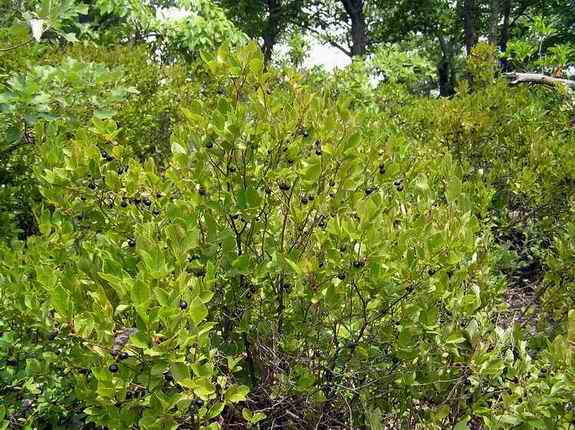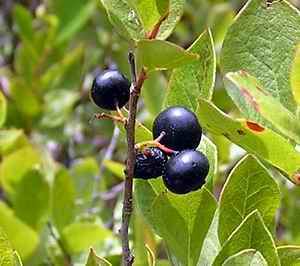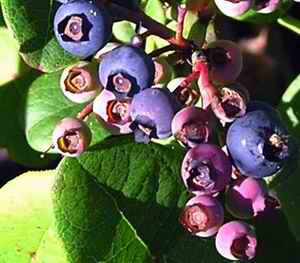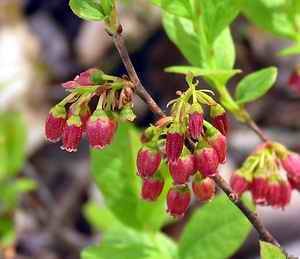|
Return to Hiker's Notebook Home Page
Common Name: Huckleberry, black huckleberry, bilberry, blueberry, whortleberry - Huckleberry is a North American colloquial form of hurtleberry, the common name of a similar berry in England (also known as whortleberry). It is postulated that the name hurtleberry is derived from 'hurt' in reference to the dark, bruised color of the fruit. The names bilberry and blueberry are erroneously applied to the huckleberry due to similarities in the appearance of the berries.
Scientific Name: Gaylussacia baccata - The genus was chosen to honor of Joseph Louis Gay-Lussac, the noted French chemist who first determined that the pressure of a fixed volume of gas was proportional to the temperature (P/T = Constant) which is known as Gay-Lussac's Law. He had nothing to do with the huckleberry. The species name is derived from the Latin baca or bacca, which means berry or anything that has the shape of a berry. Alternative scientific names include Andromeda baccata, G. resinosa, and Vaccinium resinosum.
There are over 40 species of huckleberries in the United States; often
mistakenly called blueberries due to the similarity in their appearance. There
are some notable distinguishing characteristics between huckleberries and
blueberries, however. Huckleberries tend to be more widely separated on the
plant; blueberries, on the other hand, tend to grow more in clusters. Sampling
the fruit provides another
Huckleberry has an interesting etymology as an idiomatic word in the American English language, as epitomized in Mark Twain's "The Adventures of Huckleberry Finn." Since the berries of the plant are of such diminutive size and dark in color, they came to be associated with anything that was insignificant and humble in nature or character. Mark Twain related to an interviewer in 1895 that he chose the name for the character as a contrast to Tom Sawyer, to express that he was to be of "lower extraction or degree." An interesting extension of this expression used the relatively large size of the persimmon as a contrast to the huckleberry. Thus the expression "a huckleberry over one's persimmon" meant that the object at hand was just slightly beyond reach. Finally, and perhaps due to Twain's title character, huckleberry came to be associated with a close friend as a sign of affection as in "I'm your huckleberry."
Contributing to the confusion regarding the correct identification of the huckleberry and the blueberry, the huckleberries of western North America are in the genus Vaccinium, the same genus of the blueberry. And, like their eastern counterparts, they are commonly called blueberries, bilberries and/or whortleberries. The western black huckleberry, Vaccinium membranaceum, is the state fruit of Idaho and was an important food source for many of the western Indian tribes. The Indians of the Columbia Plateau held a first fruits ceremony to coincide with the first huckleberry harvest in July, ultimately gathering about five gallons of dried berries for the winter. The Nez Perce made a purple dye from the huckleberry that was used to make corn husk bags.
The huckleberries of eastern North America a predominantly from the genus Gaylussacia; one other species is of particular interest, the box huckleberry (G. brachycera). Considered by some to be the world's oldest living organism, one colony of box huckleberry in Pennsylvania is estimated to be 13,000 years old. This, however, is based on extrapolating an average growth rate of six inches a year and not on carbon dating or a count of rings. The pink flowers and light blue fruit of the box huckleberry make it easy to distinguish it from the red flowers and black fruit of the black huckleberry. |


 identifying
characteristic; the huckleberry has 10 seeds that are large enough to be
discernible on consumption; blueberries have as many as 65 seeds, but they are
small and not discernible. Huckleberries are mostly dark, almost black in
coloration with a nearly unbroken skin. Blueberries generally have a
distinctly bluish hue. While both huckleberries and blueberries have a
calyx-lobe on the berry (the calyx is the ring of protective leaves at the
base of the flower that produced the ovary for the berry), that of the
blueberry is generally more pronounced.
identifying
characteristic; the huckleberry has 10 seeds that are large enough to be
discernible on consumption; blueberries have as many as 65 seeds, but they are
small and not discernible. Huckleberries are mostly dark, almost black in
coloration with a nearly unbroken skin. Blueberries generally have a
distinctly bluish hue. While both huckleberries and blueberries have a
calyx-lobe on the berry (the calyx is the ring of protective leaves at the
base of the flower that produced the ovary for the berry), that of the
blueberry is generally more pronounced.